Pontormo (1494-1557)
We Perform Pontormo art authentication. Pontormo appraisal. Pontormo certificates of authenticity (COA). Pontormo analysis, research, scientific tests, full art authentications. We will help you sell your Pontormo or we will sell it for you.

Jacopo Carucci, usually known as Jacopo da Pontormo, Jacopo Pontormo or simply Pontormo, was an Italian Mannerist painter and portraitist from the Florentine school. He was famous for his use of contorted poses, distorted perspective and peculiar, markedly unnatural colors, which appear to mirror his restless, neurotic temperament.
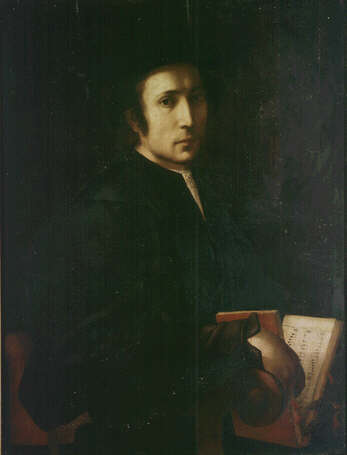
Jacopo Carucci was born at Pontorme, near Empoli. Vasari relates how the orphaned boy, “young, melancholy and lonely,” was shuttled around as a young apprentice: Jacopo had not been many months in Florence before Bernardo Vettori sent him to stay with Leonardo da Vinci, and then with Mariotto Albertinelli, Piero di Cosimo, and finally, in 1512, with Andrea del Sarto, with whom he did not remain long, for after he had done the cartoons for the arch of the Servites, it does not seem that Andrea bore him any good will, whatever the cause may have been.
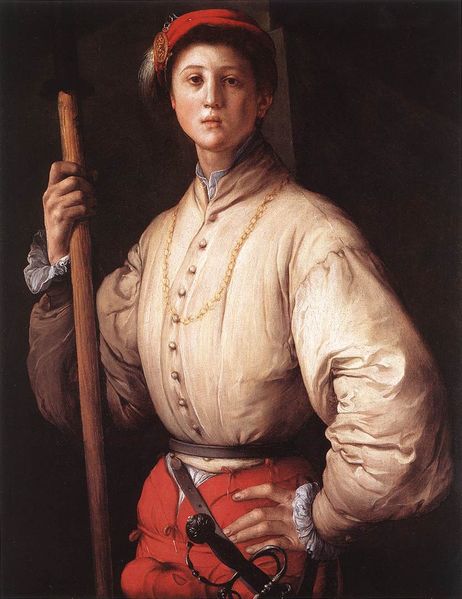
Pontormo painted only in and around Florence, supported by Medici patronage. A foray to Rome, largely to see Michelangelo’s work, influenced his later style. Haunted faces and elongated bodies are characteristic of his work. An example of Pontormo’s early style is The Visitation of the Virgin and St Elizabeth, with its dancelike, balanced figures, painted from 1514 to 1516 for the parish church of St. Michele in Carmignano, a few miles from Florence. In 1519-20 Pontormo also took part in the fresco decoration of the salon of the Medici country villa at Poggio a Caiano, not far from Florence. There he painted frescoes in a pastoral genre style, very uncommon for Florentine painters; their subject was the obscure classical myth of Vertumnus and Pomona in a lunette.

In 1522, when the plague broke out in Florence, Pontormo left for the Certosa di Galuzzo, a cloistered Carthusian monastery where the monks followed vows of silence. He painted a series of frescoes, now quite damaged, on the passion and resurrection of Christ. The large altarpiece canvas for the Brunelleschi-designed Capponi Chapel in the church of Santa Felicita in Florence, portraying The Deposition from the Cross, is considered by many his surviving masterpiece (1528). The decoration in the dome of the chapel is now lost, but four roundels with the Evangelists still adorn the pendentives, worked on by both Pontormo and Agnolo Bronzino.
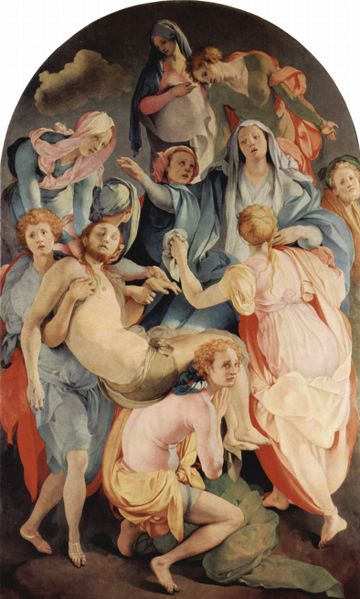
The figures, with their sharply modeled forms and bright, harsh colors are united in a stark and flattened space. Those who are lowering Christ appear as anguished as the mourners. This bleak and tumultuous oval of figures took three years for Pontormo to complete. He collaborated on the rest of its decor so intimately with Bronzino, his chief pupil, that specialist’s dispute which roundels each of them painted.
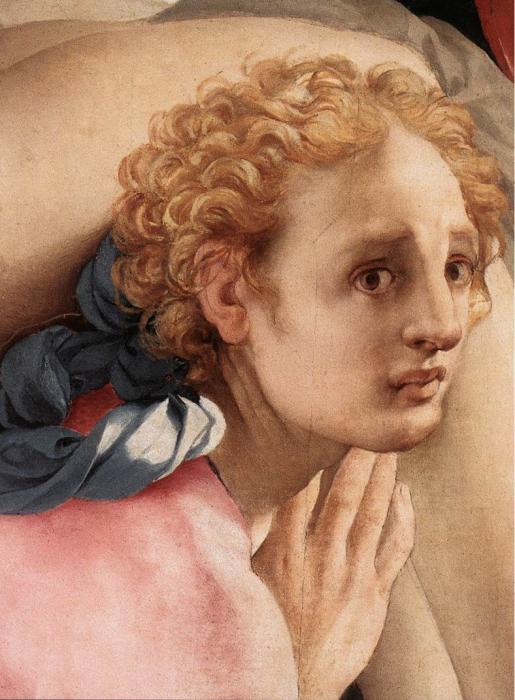
Also by Pontormo is the Annunciation frescoed on adjacent columns, which resembles his Visitation in the church of San Francesco e Michele at Carmignano in both the style and swaying postures.

The nearby Uffizi Gallery holds his mystical Supper at Emmaus as well as portraits. Many of Pontormo’s well known canvases, such as Joseph being sold to Potiphar and the Martyrdom of St Maurice and the Theban Legion (c. 1531) depict crowds milling about in awkward contrapposto of greatly varied positions. His portraits, acutely characterized, show similarly Mannerist proportions.
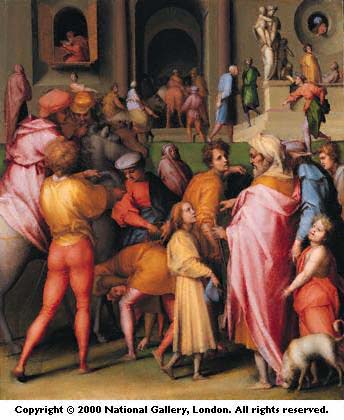
Many of Pontormo’s works have been damaged, including the lunnettes for the cloister in the Carthusian monastery of Galluzo. Most tragic is the loss of the unfinished frescoes for the church of San Lorenzo which consumed the last decade of his life. His frescoes depicted a judgment day composed of an unsettling morass of writhing figures. The film of Giovanni Fago, Pontormo, a heretical love evokes his lonely and ultimately paranoid dedication to this project, which he often kept shielded from onlookers. The remaining drawings, showing a bizarre and mystical ribboning of bodies, had an almost hallucinatory effect. Florentine figure painting had mainly stressed linear and upright sculptural figures. Jesus in the Sistine Chapel wall is a massive painted block stern in his judgment; by contrast, Pontormo’s Jesus in the Last Judgment squirms sinuously, as if rippling through the heavens in the dance of ultimate finality. Heaps of liquefied angels amass about him. In his Last Judgment Pontormo went against pictorial and theological tradition by placing God the Father at the feet of Christ, instead of above him, an idea Vasari found deeply disturbing:
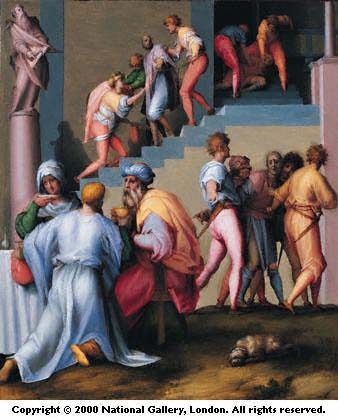
Vasari’s Life of Pontormo, depicting him as withdrawn and steeped in neurosis while at the center of the artists and patrons of his lifetime, makes a fine introduction to the artistic life of the 16th century. A diary of his last two years survives. His personality and idiosyncrasies gave Pontormo a style that few were able to imitate with the exception of Bronzino. He shares some of the mannerism of Rosso Fiorentino and of Parmigianino. In some ways he anticipated the Baroque as well as the tensions of El Greco. His eccentricities also resulted in an original sense of composition. At best, his compositions are cohesive. The figures in the Deposition, for example, appear to sustain each other: removal of any one of them would cause the edifice to collapse. In lesser works, as in the Joseph canvases, the crowding makes for a confusing pictorial melee. It is in the later drawings that we see a graceful fusion of bodies in a composition which includes the oval frame of Jesus in the Last Judgment
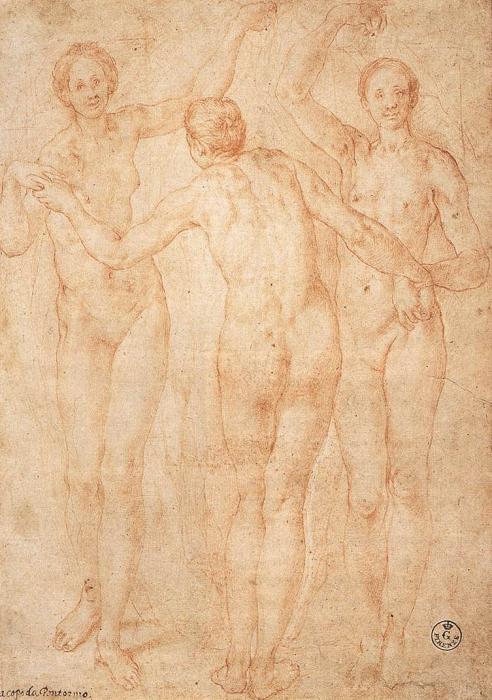
Anthology of works:
Leda and the Swan |
1512-1513 |
Uffizi Gallery, Florence |
|
Holy Conversation |
1514 |
San Luca Chapel, Santa Annunziata, Florence. |
|
Episode of Hospital Life |
1514 |
Accademia, Florence |
|
Veronica and the Image |
1515 |
Medici Chapel, Santa Maria Novella, Florence |
|
Visitation |
1514-1516 |
Santa Annunziata, Florence |
|
Lady with Basket of Spindles(attributed to Andrea del Sarto) |
1516-1517 |
Uffizi Gallery, Florence |
|
Marriage bedchamber panels for Pier Francesco Borgherini. (Two others by Francesco Bachiacca) |
|||
Joseph reveals himself to his brothers |
1516-17 |
National Gallery, London |
|
Joseph sold to Potiphar |
1516-17 |
National Gallery, London |
|
Joseph’s Brothers Beg for Help |
1515 |
National Gallery, London |
|
Pharaoh with his Butler and Baker |
1516-1517 |
National Gallery, London |
|
Joseph in Egypt |
1517-18 |
National Gallery, London |
|
*St. Quentin (Also attributed to Giovanni Maria Pichi) |
1517 |
Pinacoteca comunale, Sansepolcro |
|
Portrait of Furrier |
1517-1518 |
Louvre, Paris |
|
Madonna with Child and Saints |
1518 |
San Michele Visdomini, Florence |
|
Portrait of Musician |
1518-1519 |
Uffizi Gallery, Florence |
|
St Anthony Abbott |
1518-1519 |
Uffizi Gallery, Florence |
|
Portrait of Cosimo the Elder |
1518-1519 |
Uffizi Gallery, Florence |
|
John the Evangelist & the Archangel Gabriel |
1519 |
Church of S. Michele, Empoli |
|
Adoration of the Magi |
1519-21 |
Palazzo Pitti, Florence |
|
Vertumnus and Pomona |
1519-1521 |
Villa Medici, Poggio a Caiano |
|
Study of Man’s Head (Drawing) |
Metropolitan Museum of Art, New York City |
||

Mary and Child with Four saints |
1520-30 |
Metropolitan Museum, New York City |
|
Portrait of two friends |
c. 1522 |
Fondazione Giorgio Cini, Venice |
|
Madonna with Child & Two Saints (Bronzino?) |
c. 1522 |
Uffizi Gallery, Florence |
|
Holy Family with St John |
1522-1524 |
Hermitage Museum, St Petersburg |
|
Holy Family with St John |
1522-1524 |
Hermitage Museum, St Petersburg |
|
Madonna with Child & St John {Attributed to Rosso Fiorentino) |
1523-1525 |
Uffizi Gallery, Florence |
|
Prayer in Gesthemane (copies by Jacopo da Empoli) |
1523-1525 |
Certosa di Galluzo |
|
Walk to Calvary |
1523-1525 |
Certosa di Galluzo |
|
Christ before Pilate |
1523-1525 |
Certosa di Galluzo |
|
Deposition |
1523-1525 |
Certosa di Galluzo |
|
Resurrection |
1523-1525 |
Certosa di Galluzo |
|
Supper in Emmaus |
1525 |
Uffizi Gallery, Florence |
|
Study of a Carthusian Monk (Drawing) |
1525 |
Uffizi Gallery, Florence |
|
Madonna and child & two angels |
1525 |
San Francisco Museum Art, San Francisco |
|
Portrait of young man in pink |
1525-1526, |
Pinacoteca Communale, Lucca. |
|
Tabernacle of San Giuliano, Boldrone, Crucifix with Madonna & St. John, and Sant’Agostino |
1525-1526: |
Accademia, Florence |
|
Birth of St. John Baptist |
1526 |
Uffizi Gallery, Florence |
|
Saint Jerome Penitent |
1526-1527 |
Landesmuseum, Hannover. |
|
Madonna with Child & St John (Bronzino?) |
1526-1528 |
Palazzo Corsini, Florence. |
|
Madonna with Child & St John |
1527-1528. |
Uffizi Gallery, Florence |
|
Matthew, Luke, & John (Mark painted by Bronzino) |
1525-1526 |
Santa Felicita, Capponi Chapel, Florence. |
|
Deposition |
1526-1528 |
Santa Felicita, Capponi Chapel, Florence. |
|
Annunciation |
1527-1528 |
Santa Felicita, Capponi Chapel, Florence. |
|
Portrait of Francesca Capponi, as St. Mary Magdalen |
1527-1528 |
Whitfield Fine Art, London. |
|
Visitation |
1528-1529 |
Church of San Francesco e Michele, Carmignano |
|
Madonna with Child, Saint Anne and Four saints |
1528-1529 |
Louvre Museum, Paris. |
|
Eleven Thousand Martyrs |
1529-1530 |
Palazzo Pitti, Florence |

Mature works (after 1530)
Martyrdom of San Maurizio and the Theban Legions (Pontormo & Bronzino) |
1531 |
Uffizi Gallery, Florence |
|
Noli me Tangere (Bronzino?) |
1531 |
Casa Buonarroti, Florence |
|
Portrait of lady in red with puppy, (Bronzino?) |
1532-1533 |
Städelsches Kunstinstitut, Frankfurt |
|
Venus and Cupid |
1532-1534 |
Galleria dell’Accademia, Florence |
|
Portrait of Alessandro de’ Medici |
c. 1534-1535 |
Philadelphia Museum of Art, Philadelphia |
|
Portrait of Alessandro de’ Medici |
c. 1534-1535 |
Art Institute of Chicago, Chicago |
|
Adam and Eve |
1535 |
Uffizi Gallery, Florence |
|
Study for the Three Graces (Drawing) |
1535 |
Uffizi Gallery, Florence |
|
Portrait of Halberdier |
1537 |
Getty Museum, Los Angeles |
|
Portrait of Niccolò Ardinghelli |
National Gallery, Washington D.C. |
||
Portrait of Maria Salviati |
1543-1545 |
Uffizi Gallery, Florence |
|
Sacrificial Scene |
c. 1545 |
Capodimonte Museum, Naples |
|
My Book (Pontormo’s Diary) |
1554-1556 |
National Library, Florence |
|
Portrait of Pontormo (Bronzino) |
|||
St. Francis (Drawing) |
Museum of Fine Arts, Boston |
||
San Lorenzo (Fresco cartoons) |

Still wondering about an Italian painting in your family collection? Contact us…it could be by Pontormo
Reviews
1,217 global ratings
5 Star
4 Star
3 Star
2 Star
1 Star
Your evaluation is very important to us. Thank you.
